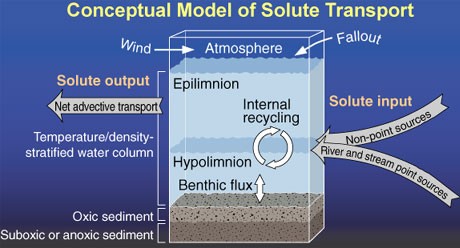Home
Page (Overview)
Project
Staff
San
Francisco Bay, CA
Lake
Coeur d'Alene, ID
Lahonton
Reservoir, NV
Camp
Far West Reservoir, CA
Guadalupe
River Watershed, CA
Upper
Klamath Lake, OR
U.S. Patent: Porewater Proflier
Library/Links
Bibliography |

PROJECT OVERVIEW
Availability of toxic
substances and nutrients to biota is dependent, among other factors,
on their distribution and chemical form. Because interdependent physical,
chemical, and biological processes regulate the distribution, speciation,
and partitioning of biologically reactive solutes, understanding
and quantifying solute interactions with biota can be important in
developing water-quality models to justify policy and decision-making.
As depicted in the conceptual model below, physical processes (for
example, point and non-point advective and diffusive fluxes, as
well as atmospheric interactions) distribute solutes to where
chemical and biological reactions and transformations may occur.
Just as temperature and density stratification is physically
generated to form an epilimnion and hypolimnion in
lakes and reservoirs, so too are chemical and biological gradients
generated in both the water column and sediment. The objective of
this project is to study and quantitatively describe such processes
that regulate the transport of trace inorganic solutes in surface-water
systems.
In many aquatic systems facing a long
(decadal to century) history of anthropogenic inputs, solute accumulation
in bottom oxic and anoxic sediments and biologically mediated
chemical gradients at the sediment-water interface can generate a
benthic source that may rival or even dramatically exceed regulated
point sources. Therefore, the importance of this benthic flux (a
form of internal recycling of solutes) relative to regulated or monitored sources is a focus of the project. To aid in the evaluation of remediation and load-allocation strategies, factors contributing to the temporal and spatial variability of the benthic flux of contaminants are also being examined in a variety of aquatic system
To further the understanding of benthic flux, a metal-free porewater profiler was developed. It samples the porewater at varying depths. The resulting samples are analyzed, and the gradient between depths can be used to calculate a diffusive flux. In November, 2011, a U.S. patent (#8,051,727 B1) was issued for the apparatus. For more details, see: Porewater Profiler - U.S. patent
|


